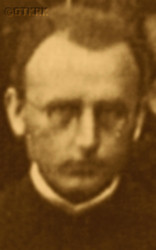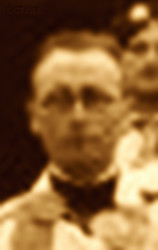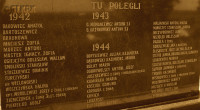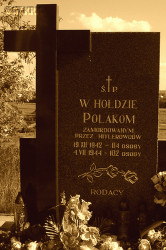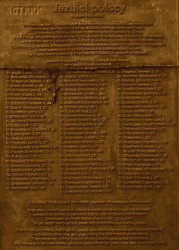Roman Catholic
St Sigismund parish
05-507 Słomczyn
85 Wiślana Str.
Konstancin deanery
Warsaw archdiocese, Poland
full list:
displayClick to display full list

searchClick to search full list by categories
wyświetlKliknij by wyświetlić pełną listę po polsku

szukajKliknij by przeszukać listę wg kategorii po polsku

Martyrology of the clergy — Poland
XX century (1914 – 1989)
personal data
surname
GRZYBOWSKI
forename(s)
Anthony (pl. Antoni)
function
religious cleric
creed
Latin (Roman Catholic) Church RCmore on
en.wikipedia.org
[access: 2014.09.21]
congregation
Society of Jesus SImore on
en.wikipedia.org
[access: 2014.09.21]
(i.e. Jesuits)
diocese / province
Greater Poland‐Mazovian province SI
Polish Province SI (1918‐1926)
date and place
of death
20.10.1943

Albertintoday: part of Slonim, Slonim dist., Grodno reg., Belarus
more on
en.wikipedia.org
[access: 2021.09.29]
alt. dates and places
of death
Slonimtoday: Slonim dist., Grodno reg., Belarus
more on
en.wikipedia.org
[access: 2021.09.29]
Petralevichitoday: Petralevichi 1 and Petralevichi 2, Pavlovo ssov., Slonim dist., Grodno reg., Belarus
more on
be.wikipedia.org
[access: 2023.01.18]
details of death
After German and Russian invasion of Poland in 09.1939 and start of the World War II, after German attack on 22.06.1941 of their erstwhile ally, Russians, and start of German occupation got involved in efforts to help persecuted Jews (among others was hiding a Jesuit Jewish novice).
The ghetto in nearby Baranavichy was liquidated by the Germans on 20.08.1942, in a bloody pacification operation, and the last prisoners cleaning up the remains were murdered in 12.1942.
It was around this time that the Germans closed also he Jesuit monastery in Albertin.
However, remained there, taking care of the Latin–rite chapel.
For an unknown reason exposed himself to the wrath of Russians, who sentenced him in absentia in Moscow to death.
The sentence was carried out by local Russian Communist partisans, dressed in German uniforms: was woken up during the night, not permitted to change clothes and executed in the forest, 4 km from Albertin.
Body was buried on murder site.
His name appears on the monument to those murdered at Petralevichi by Germans.
cause of death
murder
perpetrators
Russians
sites and events
Pietralewicka HillClick to display the description, Help to the JewsClick to display the description, Ribbentrop‐MolotovClick to display the description, Pius XI's encyclicalsClick to display the description
date and place
of birth
16.11.1904

Zawalinytoday: Wola Mysłowska gm., Łuków pov., Lublin voiv., Poland
more on
pl.wikipedia.org
[access: 2021.12.19]
alt. dates and places
of birth
14.11.1904
presbyter (holy orders)
ordination
24.06.1936

Lublintoday: Lublin city pov., Lublin voiv., Poland
more on
en.wikipedia.org
[access: 2021.08.20]
positions held
till 1943
chaplain — Albertintoday: part of Slonim, Slonim dist., Grodno reg., Belarus
more on
en.wikipedia.org
[access: 2021.09.29] ⋄ Sacred Heart of Jesus monastery (known as Eastern Mission), Jesuits SI ⋄ Sacred Heart of Jesus and the Blessed Virgin Mary RC chapel ⋄ BS parish ⋄ Slonimtoday: Slonim dist., Grodno reg., Belarus
more on
en.wikipedia.org
[access: 2021.09.29] RC deanery
c. 1938 – 1942
friar — Albertintoday: part of Slonim, Slonim dist., Grodno reg., Belarus
more on
en.wikipedia.org
[access: 2021.09.29] ⋄ Sacred Heart of Jesus monastery (known as Eastern Mission), Jesuits SI
1933 – 1936
student — Lublintoday: Lublin city pov., Lublin voiv., Poland
more on
en.wikipedia.org
[access: 2021.08.20] ⋄ theology, Theological Department („Bobolanum” college), Jesuits SI
1928 – 1931
student — Krakówtoday: Kraków city pov., Lesser Poland voiv., Poland
more on
en.wikipedia.org
[access: 2021.06.07] ⋄ philosophy, College (Lat. Collegium Maximum SS. Cordis Iesu, 26 Kopernik Str.), Jesuits SI
17.05.1922
accession — Kalisztoday: Kalisz city pov., Greater Poland voiv., Poland
more on
en.wikipedia.org
[access: 2020.12.16] ⋄ Visitation of the Blessed Virgin Mary monastery, Jesuits SI
sites and events
descriptions
Pietralewicka Hill: A small hill nearby Pietralewicze village by the Baranavichy town, place of German mass murders, mainly Jews, but also of local Polish intelligentsia. From 10,000 to 21, 000 victims might have been murdered there (or even as many as 42,000). (more on: kresowiacy.comClick to attempt to display webpage
[access: 2013.12.27], www.sztetl.org.plClick to attempt to display webpage
[access: 2013.12.27])
Help to the Jews: During World War II on the Polish occupied territories Germans forbid to give any support to the Jews under penalty of death. Hundreds of Polish priests and religious helped the Jews despite this official sanction. Many of them were caught and murdered.
Ribbentrop‐Molotov: Genocidal Russian‐German alliance pact between Russian leader Joseph Stalin and German leader Adolf Hitler signed on 23.08.1939 in Moscow by respective foreign ministers, Mr. Vyacheslav Molotov for Russia and Joachim von Ribbentrop for Germany. The pact sanctioned and was the direct cause of joint Russian and German invasion of Poland and the outbreak of the World War II in 09.1939. In a political sense, the pact was an attempt to restore the status quo ante before 1914, with one exception, namely the „commercial” exchange of the so‐called „Kingdom of Poland”, which in 1914 was part of the Russian Empire, fore Eastern Galicia (today's western Ukraine), in 1914 belonging to the Austro‐Hungarian Empire. Galicia, including Lviv, was to be taken over by the Russians, the „Kingdom of Poland” — under the name of the General Governorate — Germany. The resultant „war was one of the greatest calamities and dramas of humanity in history, for two atheistic and anti‐Christian ideologies — national and international socialism — rejected God and His fifth Decalogue commandment: Thou shall not kill!” (Abp Stanislav Gądecki, 01.09.2019). The decisions taken — backed up by the betrayal of the formal allies of Poland, France and Germany, which on 12.09.1939, at a joint conference in Abbeville, decided not to provide aid to attacked Poland and not to take military action against Germany (a clear breach of treaty obligations with Poland) — were on 28.09.1939 slightly altered and made more precise when a treaty on „German‐Russian boundaries and friendship” was agreed by the same murderous signatories. One of its findings was establishment of spheres of influence in Central and Eastern Europe and in consequence IV partition of Poland. In one of its secret annexes agreed, that: „the Signatories will not tolerate on its respective territories any Polish propaganda that affects the territory of the other Side. On their respective territories they will suppress all such propaganda and inform each other of the measures taken to accomplish it”. The agreements resulted in a series of meeting between two genocidal organization representing both sides — German Gestapo and Russian NKVD when coordination of efforts to exterminate Polish intelligentsia and Polish leading classes (in Germany called «Intelligenzaktion», in Russia took the form of Katyń massacres) where discussed. Resulted in deaths of hundreds of thousands of Polish intelligentsia, including thousands of priests presented here, and tens of millions of ordinary people,. The results of this Russian‐German pact lasted till 1989 and are still in evidence even today. (more on: en.wikipedia.orgClick to attempt to display webpage
[access: 2015.09.30])
Pius XI's encyclicals: Facing the creation of two totalitarian systems in Europe, which seemed to compete with each other, though there were more similarities than contradictions between them, Pope Pius XI issued in 03.1937 (within 5 days) two encyclicals. In the „Mit brennender Sorge” (Eng. „With Burning Concern”) published on 14.03.1938, condemned the national socialism prevailing in Germany. The Pope wrote: „Whoever, following the old Germanic‐pre‐Christian beliefs, puts various impersonal fate in the place of a personal God, denies the wisdom of God and Providence […], whoever exalts earthly values: race or nation, or state, or state system, representatives of state power or other fundamental values of human society, […] and makes them the highest standard of all values, including religious ones, and idolizes them, this one […] is far from true faith in God and from a worldview corresponding to such faith”. On 19.03.1937, published „Divini Redemptoris” (Eng. „Divine Redeemer”), in which criticized Russian communism, dialectical materialism and the class struggle theory. The Pope wrote: „Communism deprives man of freedom, and therefore the spiritual basis of all life norms. It deprives the human person of all his dignity and any moral support with which he could resist the onslaught of blind passions […] This is the new gospel that Bolshevik and godless communism preaches as a message of salvation and redemption of humanity”… Pius XI demanded that the established human law be subjected to the natural law of God , recommended the implementation of the ideal of a Christian state and society, and called on Catholics to resist. Two years later, National Socialist Germany and Communist Russia came together and started World War II. (more on: www.vatican.vaClick to attempt to display webpage
[access: 2023.05.28], www.vatican.vaClick to attempt to display webpage
[access: 2023.05.28])
sources
personal:
www.glaukopis.plClick to attempt to display webpage
[access: 2012.11.23], www.bialystok.opoka.org.plClick to attempt to display webpage
[access: 2013.01.06], kielakowie.plClick to attempt to display webpage
[access: 2013.05.19], www.jezuici.krakow.plClick to attempt to display webpage
[access: 2015.03.01]
bibliographical:
„Vilnius archdiocese clergy martyrology 1939‐1945”, Fr Thaddeus Krahel, Białystok, 2017
„Jesuits on Polish and Lithuanian territory knowledge encyclopedia, 1564‐1995”, Fr Louis Grzebień SI (editor), WAM Printing House, Cracow 1996
original images:
foto.karta.org.plClick to attempt to display webpage
[access: 2015.05.09], foto.karta.org.plClick to attempt to display webpage
[access: 2015.05.09], www.flickr.comClick to attempt to display webpage
[access: 2014.01.06], www.flickr.comClick to attempt to display webpage
[access: 2014.01.06], www.miejscapamiecinarodowej.plClick to attempt to display webpage
[access: 2014.05.09]
LETTER to CUSTODIAN/ADMINISTRATOR
If you have an Email client on your communicator/computer — such as Mozilla Thunderbird, Windows Mail or Microsoft Outlook, described at WikipediaPatrz:
en.wikipedia.org, among others — try the link below, please:
LETTER to CUSTODIAN/ADMINISTRATORClick and try to call your own Email client
If however you do not run such a client or the above link is not active please send an email to the Custodian/Administrator using your account — in your customary email/correspondence engine — at the following address:

giving the following as the subject:
MARTYROLOGY: GRZYBOWSKI Anthony
To return to the biography press below:
 Click to return to biography
Click to return to biography








